
British postcard by Art Photo Postcard, no. 36-2. Caption: Franchot Tone - Born within sound of Niagara Falls. Graduated at Cornell University. Has appeared in Straight is the Way and Reckless. Weighs 11 1/2 st. and is 9 ft. tall.

British postcard by Film Weekly. Photo: MGM. Jean Harlow and Franchot Tone in the American pre-Code screwball comedy Blonde Bombshell/Bombshell (Victor Fleming, 1933).

Dutch postcard, no. 571. Photo: George Hurrell / Metro-Goldwyn-Mayer (MGM). Joan Crawford and Franchot Tone in Dancing Lady (Robert Z. Leonard, 1933).
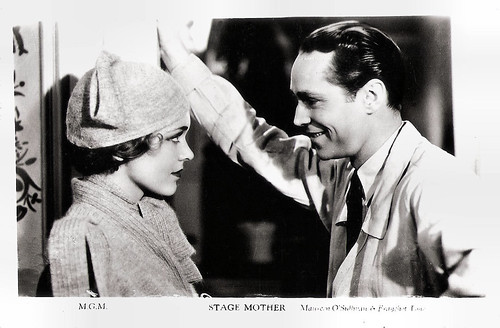
British postcard in the Filmshots series by Film Weekly. Photo: M.G.M. Maureen O'Sullivan and Franchot Tone in Stage Mother (Charles Brabin, 1933).

British postcard in the Film Partners Series, London, no. PC 133. Photo: Metro-Goldwyn-Mayer. Franchot Tone and Joan Crawford in Sadie McKee (Clarence Brown, 1934).
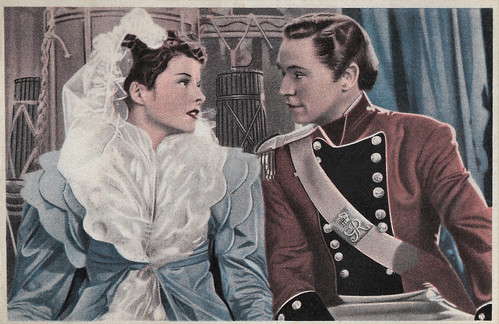
Italian postcard by Generalcine, Roma / Off. Graf. 'La Lito', Milano. Photo: RKO Radio Pictures. Katharine Hepburn and Franchot Tone in Quality Street (George Stevens, 1937).

Portuguese postcard by Postais Krohn, Porto. Deanna Durbin and Franchot Tone in His Butler’s Sister (Frank Borzage, 1943). Collection: Marlene Pilaete.
Roles as a wealthy playboy or lover of the female lead
Stanislas Pascal Franchot Tone was born in 1905 in Niagara Falls, New York. He was the son of Dr. Frank Jerome Tone, a pioneer in the electrochemistry field and the wealthy president of the Carborundum Company, and his socially prominent wife, Gertrude Van Vrancken Franchot.
Franchot became interested in acting at an early age and was president of the drama club at Cornell University during his student days. Tone was originally supposed to take over the family business, but he decided to pursue a show career. He moved to Greenwich Village in New York and was already acting on Broadway during the late 1920s, in Katharine Cornell's production of 'The Age of Innocence' (1929).
Later he also became a member of the Theatre Guild and played Curly in their production of 'Green Grow the Lilacs' (1931), which later became the basis for the musical 'Oklahoma!'. Tone was also a founding member of the Group Theatre, when the Theater Guild disbanded, along with other former guild members Harold Clurman, Cheryl Crawford, Lee Strasberg, Stella Adler, and Clifford Odets. The Group Theatre was the first acting company in America to bring Konstantin Stanislavski's revolutionary acting techniques to America.
Franchot Tone's first film was The Wiser Sex (Berthold Viertel, 1932), starring Claudette Colbert, filmed by Paramount at their Astoria Studios. Tone was the first of the Group to go to Hollywood when MGM offered him a film contract. MGM immediately gave Tone a series of impressive roles and he made his breakthrough with the romantic WWI drama Today We Live (Howard Hawks, 1933), written by William Faulkner. Tone was then the romantic male lead in Gabriel Over the White House (Gregory La Cava, 1933) starring Walter Huston. He also had an excellent role in the screwball comedy Bombshell (Victor Fleming, 1933), with Jean Harlow. The last of his 1933 films was Dancing Lady (Robert Z. Leonard, 1933 ), with an on-screen love triangle between Joan Crawford, Clark Gable and him.
In 1935 Tone married Crawford, with whom he made a total of seven films. Before the two actors divorced in 1938, Crawford had suffered several miscarriages. One of his best-known performances was as for his role as Midshipman Roger Byam in the classic adventure film Mutiny on the Bounty (Frank Lloyd, 1935), for which he received an Oscar nomination for Best Actor. Despite historical inaccuracies, the film was a huge box office success, becoming the highest-grossing film of 1935 and one of MGM's biggest hits of the 1930s. That same year he appeared in Henry Hathaway's also highly successful adventure film The Lives of a Bengal Lancer (1935) with Gary Cooper.
Warner Bros. borrowed him to play Bette Davis' leading man in Dangerous (Alfred E. Green, 1935). In his films, Tone was often entrusted with playing second leads, such as a wealthy playboy or lover of the female lead who doesn't end up getting the leading lady. After his contract ended, Tone left MGM in 1939 to act on Broadway in a return to his stage roots, often working with the Group Theatre's members of its formative years, and playwrights such as Eugene O'Neill. He returned to Broadway for Irwin Shaw's 'The Gentle People' (1939) and an adaptation of Ernest Hemingway's 'The Fifth Column' (1940), which only had a short run.
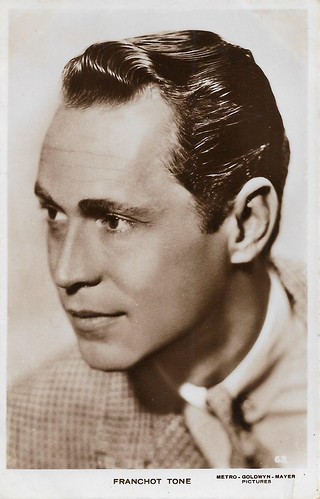
British Real Photograph postcard, no. 62. Photo: Metro-Goldwyn-Mayer Pictures.

British Real Photograph postcard, no. 63 A. Photo: Metro-Goldwyn-Mayer Pictures.
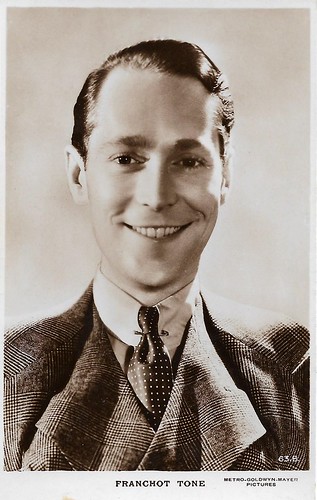
British Real Photograph postcard, no. 63 B. Photo: Metro-Goldwyn-Mayer Pictures.
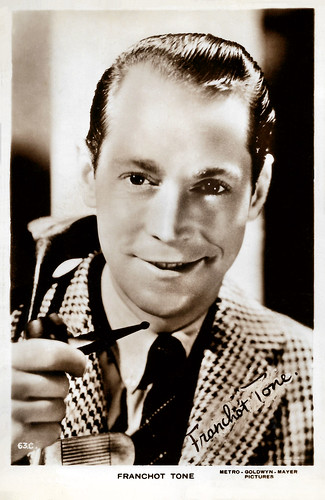
British Real Photograph postcard, no. 63 C. Photo: Metro-Goldwyn-Mayer Pictures.

Italian postcard by B.F.F. Edit., no. 3531. Photo: Metro-Goldwyn-Mayer.

Italian postcard by B.F.F. Edit., no. 3532. Photo: Metro-Goldwyn-Mayer.
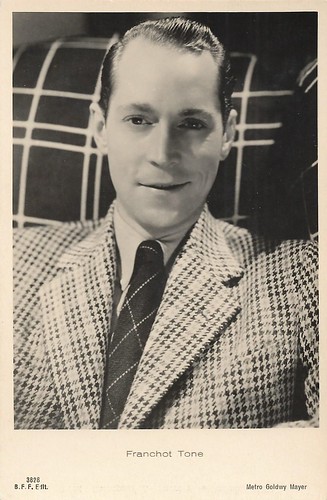
Italian postcard by B.F.F. Edit., no. 3828. Photo: Metro-Goldwyn-Mayer.
A love rival in the battle for Barbara Payton
In the 1940s, Franchot Tone's film career continued successfully. A departure from his usual role pattern was the lead in Billy Wilder's war film Five Graves to Cairo (1942), in which he is the sole survivor of a unit of British soldiers stranded in a lonely Sahara hotel. Erich von Stroheim portrays Field Marshal Erwin Rommel in a supporting performance.
In Robert Siodmak's gritty Film Noir Phantom Lady (1944), Tone's character turns out to be a murderer at the end of the film. In 1941 he married the fashion model-turned-actress Jean Wallace, with whom he co-starred in the Film Noir, Jigsaw (Fletcher Markle, 1949). In 1948 this marriage also ended in divorce. Tone produced and starred with Charles Laughton in The Man on the Eiffel Tower (Burgess Meredith, 1949), a troubled production suffering from filming delays on location, creative wrangling and the pictures hard to transfer single-strip technicolour film stock.
In 1951 Tone married the young actress Barbara Payton, who suffered from alcohol and drug addiction. A love rival in the battle for Payton was the actor Tom Neal. A fight ensued in which Tone suffered numerous injuries and went into a coma for 18 hours. He survived and plastic surgery nearly fully restored his broken nose and cheek. He married Payton in 1951, but he divorced her just one year later, after obtaining photographic evidence she had continued her relationship with Neal. Payton and Neal capitalised on the scandal by touring with a production of 'The Postman Always Rings Twice'.
Tone was listed as one of "Stalin's Stars" in the Red Treason in Hollywood published by Myron C. Fagan and was put on a Hollywood blacklist during the McCarthy era. He left Hollywood and returned to his roots in New York. There he starred again on Broadway in the big hit 'Oh, Men! Oh, Women!' (1953–1954), which ran for 400 performances. He also appeared in a revival of 'The Time of Your Life' (1955) and Eugene O'Neill's 'A Moon for the Misbegotten' (1957) with Wendy Hiller and Cyril Cusack.
He acted in numerous television shows, including as the choleric Juror No. 3 in the original television version of Twelve Angry Men (Franklin Schaffner, 1954), on which the classic film 12 Angry Men (Sidney Lumet, 1957) starring Henry Fonda was based. He also made guest appearances in series such as Bonanza and Twilight Zone. In 1956 Tone married Dolores Dorn, with whom he appeared in a film version of Uncle Vanya (1957) which Tone directed and produced. His fourth marriage also ended in divorce in 1959.
In 1960, Tone received a star on the Hollywood Walk of Fame for his film work. He made a late return to Hollywood in 1962 as a character actor in Otto Preminger's star-studded political drama Advise & Consent (1962), in which he plays the charismatic but terminally ill US president. On stage, he acted in a revival of Eugene O'Neill's 'Strange Interlude' (1963), with Ben Gazzara and Jane Fonda. He appeared in what is possibly the first TV movie, See How They Run (David Lowell Rich, 1964) with John Forsythe and Senta Berger. He had roles in Otto Preminger's film In Harm's Way (1965) in which he portrayed Admiral Husband E. Kimmel and Arthur Penn's Mickey One (1965). His last film role was in the British spy-thriller The High Commissioner/Nobody Runs Forever (Ralph Thomas, 1968) starring Rod Taylor and Christopher Plummer.
In 1968 Franchot Tone died of lung cancer at the age of 63. When Tone was dying, Joan Crawford often cared for him, paying for medical treatments and at one point, Tone suggested they remarry, but she declined the offer. He had two sons with Jean Wallace, Pascal Franchot Tone and Thomas Jefferson Tone. Tone was cremated and his ashes were kept on a shelf in his son's library, surrounded by the works of William Shakespeare, until 2022, when they were interred in the Point Comfort Cemetery in Quebec, Canada.

French postcard, no. 28. Photo: Metro-Goldwyn-Mayer.
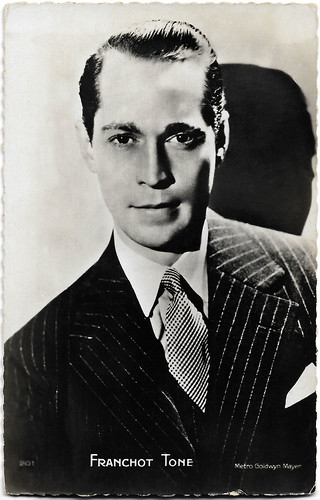
French postcard by Editions P.I., Paris, no. 201. Photo: Metro-Goldwyn-Mayer.

British postcard by Film Weekly. Photo: MGM. Miriam Hopkins, Stuart Erwin, Franchot Tone and Lionel Barrymore in The Stranger's Return (King Vidor, 1933).

British postcard by Film Weekly. Photo: MGM. Karen Morley and Franchot Tone in Gabriel over the White House (Gregory La Cava, 1933).

British postcard by Film Weekly. Photo: MGM. Walter Huston, Karen Morley and Franchot Tone in Gabriel over the White House (Gregory La Cava, 1933).

British postcard by Film Weekly. Photo: MGM. Walter Huston, Franchot Tone and Karen Morley in Gabriel over the White House (Gregory La Cava, 1933).

British postcard in the Picturegoer Series, London, no. 956. Photo: Paramount. Franchot Tone in The Lives of a Bengal Lancer (Henry Hathaway, 1935).
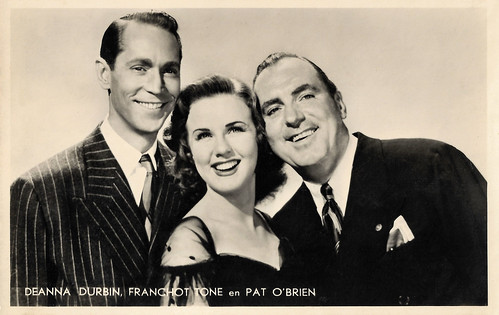
Dutch postcard by J.S.A. (J. Sleding, Amsterdam. Photo: F.B.O. - M.P.E. / Universal. Deanna Durbin, Franchot Tone and Pat 'O Brien in His Butler's Sister (Frank Borzage, 1943).
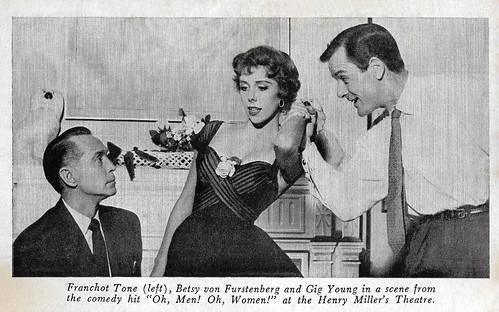
American postcard, no. 491. Franchot Tone, Betsy von Fürstenberg and Gig Young in the comedy play 'Oh, men! Oh, women!' (1953) by Edward Chodorov at the Henry Miller's Theatre (now Stephen Sondheim Theatre), New York City. John Chapman, N. Y. Daily News said: "Happy, Hilarious and Human". Walter Kerr, N.Y. Herald Tribune said: "Extremely Funny - A Dandy Show."
Sources: William McPeak (IMDb), Wikipedia (German, Dutch and English) and IMDb.
No comments:
Post a Comment